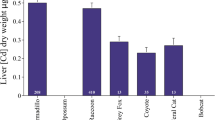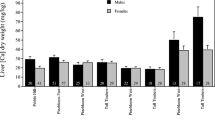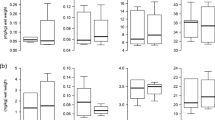Abstract
Bobcats (Lynx rufus) are wide-ranging mammals found throughout the continental USA. As carnivores near the top of their food chain, bobcats would seem to be a useful bioindicator of metal pollution in terrestrial environments. However, there is very limited research on bobcats in toxicology studies. Here, we offer the first analysis of metal (copper, selenium, silver, and zinc) contaminants in the livers of wild bobcats. Liver tissues from 120 adult bobcats (i.e., estimated to be ≥1 year old) were collected from 2003 to 2006 at four sites in Georgia and Florida, USA that experienced relatively similar levels of human disturbance. We found no differences in metal concentrations between males and females. At two of the sites sampled over three consecutive years, there was substantial year-to-year variation in the concentrations of Cu, Se, and Zn. We also documented some variation between sites, but only between sites sampled in different years, which may reflect additional temporal, rather than spatial, variation. Concentrations of Cu and Ag were significantly positively correlated with one another, as were concentrations of Se and Zn. Contrary to expectation, there were no significant relationships between body weight and metal concentrations. Finally, comparison with results from previous metal toxicology studies of nine-banded armadillos (Dasypus novemcinctus) and Virginia opossums (Didelphis virgianus), collected from the same sites during the same years, showed differential patterns of accumulation across species, suggesting that ecological lifestyle is an important influence on metal accumulation. This study provides reference levels of metal contaminants in the liver of bobcats as well as insight into metal accumulation in a top level carnivore.





Similar content being viewed by others
References
Aaseth, J., & Norseth, T. (1986). Copper. In L. Friberg, G. F. Nordberg, & V. B. Vouk (Eds.), Handbook on the toxicology of metals. Second edition. Volume II: specific metals (pp. 233–254). New York: Elsevier.
Avsaroglu, D. T., Inal, T. C., Demir, M., Attila, G., Acarturk, E., Evlice, Y. E., & Kayrin, L. (2005). Biochemical indicators and cardiac functions tests in chronic alcohol abusers. Croatian Medical Journal, 46, 233–237.
Bielmyer, G. K., Tomasso, J., Gatlin, D., Isely, J., & Klaine, S. J. (2005). Responses of hybrid striped bass to waterborne and dietary copper in freshwater and saltwater. Comparative Biochemistry and Physiology Part C., 140, 131–137.
Bielmyer, G. K., Tomasso, J., & Klaine, S. J. (2006). Physiological responses of hybrid striped bass to aqueous copper in freshwater and saltwater. Archives of Environmental Contamination and Toxicology, 50, 531–538.
Bilandzic, N., Sedak, M., Dokic, M., & Simic, B. (2012). Metal concentrations in tissues of wild boar of continental Croatia. International Journal of Environment and Pollution, 2, 6–9.
Burger, J., Lord, C. G., Yurkow, E. J., & McGrath, L. (2000). Metals and metallothionein in the liver of raccoons: utility for environmental assessment and monitoring. Journal of Toxicology and Environmental Health, 60, 243–261.
Casarett, L. J., Doull, J., & Klaasen, C. D. (2008). Casarett and Doull’s toxicology: the basic science of poisons (7th ed.). New York: McGraw-Hill.
Cesur, S., Cebeci, S. A., Kavas, G. O., Aksaray, S., & Tezeren, D. (2005). Serum copper and zinc concentrations in patients with chronic hepatitis. British Journal of Infection Control, 51, 38–40.
Cook, C. C. H., Walden, R. J., Graham, B., Gillham, C., Davies, S., & Prichard, B. N. C. (1991). Trace element and vitamin deficiency in alcoholic and control subjects. Alcohol, 26, 541–548.
Crowe, D. M. (1975). Aspects of ageing, growth, and reproduction of bobcats from Wyoming. Journal of Mammalogy, 56, 177–198.
Cumbie, P. M. (1975). Mercury in hair of bobcats and raccoons. Journal of Wildlife Management, 39, 419–425.
Cumbie, P. M., Jenkins, J. H. (1974). Mercury accumulation in native mammals of the southeast. In Proceedings of the 28th Annual Conference of the Southeastern Association of Game and Fish Commissioners. United States.
Eisler, R. (1985). Selenium hazards to fish, wildlife, and invertebrates: a synoptic review. U.S. Geological Survey, Biological Resources Division, Biological Science Report, 5, 1–40.
Eisler, R. (1993). Zinc hazards to fish, wildlife, and invertebrates: a synoptic review. U.S. Fish and Wildlife Service, Biological Science Report, 10, 106.
Eisler, R. (1996). Silver hazards to fish, wildlife, and invertebrates: a synoptic review. U.S. Geological Survey, Biological Resources Division, Biological Science Report, 32, 1–63.
Eisler, R. (1997). Copper hazards to fish, wildlife, and invertebrates: a synoptic review. U.S. Geological Survey, Biological Resources Division, Biological Science Report, 33, 1–98.
Feleafel, M. N., & Mirdad, Z. M. (2013). Hazard and effects of pollution by lead on vegetable crops. Journal of Agricultural and Environmental Ethics, 26, 547–567.
Fleming, W. J., Gutenmann, W. H., & Lisk, D. J. (1979). Selenium in tissues of woodchucks inhabiting fly ash landfills. Bulletin of Environmental Contamination and Toxicology, 21, 1–3.
Flora, S. J., Mittal, M., & Mehta, A. (2008). Heavy metal induced oxidative stress and its possible reversal by chelation therapy. Indian Journal of Medical Research, 128, 501–523.
Gaines, K. F., Romanek, C. S., Boring, C. S., Lord, C. G., Gochfeld, M., & Burger, J. (2002). Using raccoons as an indicator species for metal accumulation across trophic levels: a stable isotope approach. Journal of Wildlife Management, 66, 811–821.
Goyer, R. (1996). Toxic effects of metals. In C. D. Klaassen (Ed.), Casarett & Doull’s toxicology (pp. 691–736). New York: McGraw-Hill.
Guidotti, T. L., Audette, R. J., & Martin, C. J. (1997). Interpretation of the trace metal analysis profile for patients occupationally exposed to metals. Occupational Medicine, 47, 497–503.
Jarvis, T. A., Lockhart, J. M., Loughry, W. J., & Bielmyer, G. K. (2013). Metal accumulation in wild nine-banded armadillos. Ecotoxicology, 22, 1053–1062.
Jones, J. H., & Smith, N. S. (1979). Bobcat density and prey selection in Central Arizona. Journal of Wildlife Management, 43, 666–672.
Larivière, S., & Walton, L. R. (1997). Lynx rufus. Mammalian Species, 563, 1–8.
Litvaitis, J. A., Stevens, C. L., & Mautz, W. W. (1984). Age, sex, and weight of bobcats in relation to winter diet. Journal of Wildlife Management, 48, 632–635.
Lockhart, J. M., Siddiqui, S., Loughry, W. J., & Bielmyer-Fraser, G. K. (2016). Metal accumulation in wild-caught opossum. Environmental Monitoring and Assessment, 188, 317.
Lombardi, G., Lanzirotti, A., Qualls, C., Socola, F., Ali, A. M., & Appenzeller, O. (2012). Five hundred years of mercury exposure and adaptation. Journal of Biomedicine and Biotechnology, 2012, 1–10.
Loughry, W. J., & McDonough, C. M. (1996). Are road kills valid indicators of armadillo population structure? American Midland Naturalist, 135, 53–59.
Luoma, S. N., Hogstrand, C., Bell, R. A., Bielmyer, G. K., Galvez, F., LeBlanc, G. A., Lee, B. G., Purcell, T. W., Santore, R. C., Santschi, P. H., & Shaw, J. R. (1999). In A. W. Andren & T. W. Bober (Eds.), Silver in the environment: transport, fate, and effects (pp. 65–97). Madison, Wisconsin, USA: University of Wisconsin Sea Grant.
Main, W. P. L., Ross, C., & Bielmyer, G. K. (2010). Copper accumulation and oxidative stress in the sea anemone, Aiptasia pallida, after waterborne copper exposure. Comparative Biochemistry and Physiology Part C, 151, 216–221.
Mariniakova, M., Omelka, R., Stawarz, R., & Formicki, G. (2011). Accumulation of lead, cadmium, nickel, iron, copper, and zinc in bones of small mammals from polluted areas in Slovakia. Polish Journal of Environmental Studies, 21, 153–158.
McDonough, C. M., Lockhart, J. M., & Loughry, W. J. (2007). Population dynamics of nine-banded armadillos: insights from a removal experiment. Southeastern Naturalist, 6, 381–392.
Millan, J., Mateo, R., Taggart, M. A., Lopez-Bao, J. V., Viota, M., Monsalve, L., Camarero, P. R., Blazquez, E., & Jimenez, B. (2008). Levels of heavy metals and metalloids in critically endangered Iberian lynx and other wild carnivores from southern Spain. Science of the Total Environment, 399, 193–201.
Mullally, A. M., Vogelsang, G. B., & Moliterno, A. R. (2004). Wasted sheep and premature infants: the role of trace metals in hematopoiesis. Blood Reviews, 18, 227–234.
Nriagu, J. O., & Skaar, E. P. (2015). Trace metals and infectious diseases. Cambridge, MA: MIT Press.
Nwokocha, C. R., Owu, D. U., Nwokocha, M. I., Ufearo, C. S., & Iwuala, M. O. E. (2012). Comparative study on the efficacy of Allium sativum (garlic) in reducing some heavy metal accumulation in liver of wistar rats. Food and Chemical Toxicology, 50, 222–256.
Prasad, A. S. (1979). Clinical, biochemical, and pharmacological role of zinc. Annual reviews in pharmacology and. Toxicology, 20, 393–426.
Pyati, R., Bielmyer, G. K., Chalk, S., McCarthy, D., McCarthy, H., Pinto, G., Sonnenberg, L., Welsh, P. (2012). Case study: St. Johns river basin, USA. In: Fourth United Nations World Water Development Report, World Water Assessment Programme 2012. UNESCO Publishing, France.
Riley, M. R., Boesewetter, D. E., Kim, A. M., & Francisco, P. S. (2003). Effects of metals Cu, Fe, Ni, V, and Zn on rat lung epithelial cells. Toxicology, 190, 171–182.
Roberts, N. M., & Crimmins, S. H. (2010). Bobcat population status and management in North America: evidence of large-scale population increase. Journal of Fish and Wildlife Management, 2, 169–174.
Roggeman, S., de Boeck, G., De Cock, H., Blust, R., & Bervoets, L. (2014). Accumulation and detoxification of metals and arsenic in tissues of cattle (Bos taurus), and the risks for human consumption. Science of the Total Environment, 466-467, 175–184.
Shore, R. F., & Rattner, B. A. (Eds.) (2001). Ecotoxicology of wild mammals. Ecotoxicology and environmental toxicology series. New York: Wiley.
Suzuki, K., Oyama, R., Hayashi, E., & Arakawa, Y. (1996). Liver disease and essential trace elements. Nihon Rinsho, 54, 85–92.
Wang, B. S., Goodkin, N. F., Angeline, N., Switzer, A. D., You, C. F., & Hughen, K. (2011). Temporal distributions of anthropogenic Al, Zn, and Pb in Hong Kong Porites Coral during the last two centuries. Marine Pollution Bulletin, 63, 508–515.
Wijnhoven, S., Leuven, R. S. E. W., van der Velde, G., Jungheim, G., Koelemij, E. I., de Vries, F. T., Eijsackers, H. J. P., & Smits, A. J. M. (2007). Heavy-metal concentrations in small mammals from a diffusely polluted floodplain: importance of species-and location-specific characteristics. Archives of Environmental Contamination and Toxicology, 52, 603–613.
Acknowledgments
The authors would like to thank the USDA-WS for collection of the samples, and Samreen Siddiqui and Eric Barber for assistance in analyzing some of the samples. Thanks also to Corey Anderson for advice on statistical analyses. We are grateful for the comments of two anonymous reviewers in improving this paper.
Author information
Authors and Affiliations
Corresponding author
Rights and permissions
About this article
Cite this article
Thomason, R.K., Lockhart, J.M., Loughry, W.J. et al. Metal accumulation in bobcats in the Southeastern USA. Environ Monit Assess 188, 565 (2016). https://doi.org/10.1007/s10661-016-5587-6
Received:
Accepted:
Published:
DOI: https://doi.org/10.1007/s10661-016-5587-6




